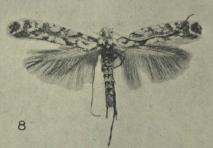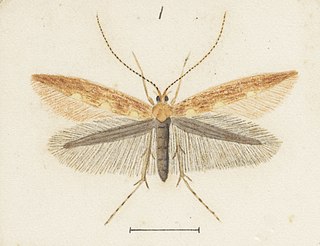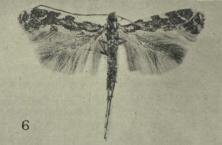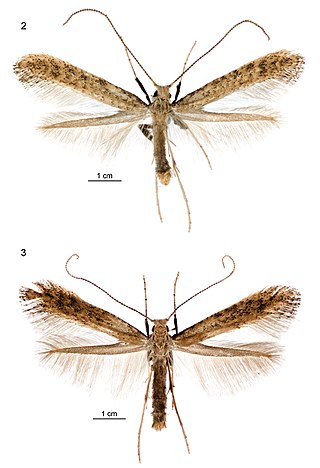
Gracillariidae is an important family of insects in the order Lepidoptera and the principal family of leaf miners that includes several economic, horticultural or recently invasive pest species such as the horse-chestnut leaf miner, Cameraria ohridella.

The European oak leaf-miner or Zeller's midget is a moth of the family Gracillariidae. It is found in Europe south of the line running from Ireland, through Great Britain, Denmark to Ukraine. It is also found in Macaronesia. It is an introduced species in New Zealand and Australia.

Macarostola miniella is a species of moth in the family Gracillariidae. It is endemic to New Zealand. This species is only found in the North Island and the adult moths have two different colour variations.

Acrocercops alysidota is a moth of the family Gracillariidae. It is known from New South Wales, Queensland, Victoria, Southern Australia and Western Australia as well as New Zealand.
Acrocercops laciniella is a moth of the family Gracillariidae. In Australia, it is known from the states of New South Wales, Queensland, Victoria, South Australia and Tasmania. It is also known from India and has recently been found in New Zealand.
Caloptilia octopunctata is a species of moth of the family Gracillariidae. It is known from the Democratic Republic of Congo, Tanzania, Uganda, South Africa, India, Australia, New Zealand and Indonesia.
Macarostola formosa is a moth of the family Gracillariidae. It is known from Australia and New Zealand.
Macarostola ida is a moth of the family Gracillariidae. It is known from Australia in the states of New South Wales, Queensland, Western Australia and Victoria. In 2019 it was discovered to have become established in Northland and east Auckland in New Zealand.

Acrocercops aellomacha is a moth of the family Gracillariidae, known from New Zealand. In 2019 Robert Hoare proposed that this species be provisionally assigned to the genus Eumetriochroa. However as this proposal needs further investigation this species is also currently known as Eumetriochroa (s.l.) aellomacha.
Acrocercops aethalota is a species of moth of the family Gracillariidae, known from New Zealand. In 2019 Robert Hoare proposed that this species be provisionally assigned to the genus Eumetriochroa. However as this proposal needs further investigation this species is also currently known as Eumetriochroa (s.l.) aetholata.
Porphyrosela hardenbergiella is a moth of the family Gracillariidae. It is known from New Zealand, but may be adventive, since the host plant is Australian. The colony known to Wise has been destroyed since its discovery. This species was last collected in New Zealand in 1955 but as at 2019 was still not known from Australia.

Caloptilia elaeas is a moth of the family Gracillariidae. It is known from New Zealand.

Caloptilia selenitis is a moth of the family Gracillariidae. It is known from New Zealand.
Caloptilia scutellariella is a moth of the family Gracillariidae. It has been recommended that this species be further studied as its placement within the genus Caloptilia is in need of clarification. It is known from Ontario, Canada, and Ohio and Michigan in the United States.

Acrocercops leucocyma, also known as the kauri leafminer, is a species of moth in the family Gracillariidae. It is endemic to New Zealand.

Acrocercops panacitorsens is a moth of the family Gracillariidae. It is known from New Zealand. In 2019 Robert Hoare proposed that this species be provisionally assigned to the genus Eumetriochroa. However as this proposal needs further investigation this species is also currently known as Eumetriochroa (s.l.) panacitorsens.

Acrocercops panacicorticis is a moth of the family Gracillariidae. It is known from New Zealand. In 2019 Robert Hoare proposed that this species be provisionally assigned to the genus Eumetriochroa. However as this proposal needs further investigation this species is also currently known as Eumetriochroa (s.l.) panacicorticis.

Acrocercops panacifinens is a moth of the family Gracillariidae. It is known from New Zealand. In 2019 Robert Hoare proposed that this species be provisionally assigned to the genus Eumetriochroa. However as this proposal needs further investigation this species is also currently known as Eumetriochroa (s.l.) panacifinens.

Uromycladium tepperianum is a rust fungus that infects over 100 species of Acacia and related genera including Paraserianthes in Australia, south-east Asia, the south Pacific and New Zealand. The acacia gall rust fungus species Uromycladium tepperianum has been introduced to South Africa as a biological control on the invasive Australian shrub Acacia saligna.

Sabulopteryx botanica is a species of moth in the family Gracillariidae. It is endemic to New Zealand. It was first described in 2019 by Robert Hoare and Brian Patrick. The larval host of this species is Teucrium parvifolium, a plant that has been classified as at risk by the Department of Conservation.






